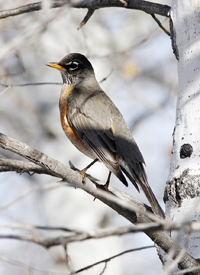Birds are the only two-legged animals that get around as much as humans. They took to the skies many millions of years ago, foregoing terrestrial comforts in favor of mobility.
While some birds never travel far from home, others fly thousands of miles each year in a winged migration that will soon bring a slew of new colors and bird song to south-central Idaho.
A murder of crows has been complaining from the top of a spruce tree on my street for the past few weeks. Like most of my friends, they have spent the entire winter here in the northern Rockies, and so have some bragging rights now that spring is rolling around.
Spring is a time when birds are visibly on the move. Some come, some go, others never left—still others are only passing through.
The crows will soon make way for a myriad of insectivore bird species that follow the emerging bounty of bugs as they hatch out farther and farther north each day under the summering sun. They include swifts and swallows, orioles, flycatchers, mockingbirds, thrashers, pipits, thrushes and warblers, to name only a few.
By spring, it's too hot around here for the rough-legged hawk, which only winters here and then wings it far to the north to breed. The same goes for shrikes and the occasional snowy owl, which are probably on their way north already.
The Silver Creek springs south of Bellevue, which never freeze, are a good year-round birding spot. Teals, mergansers and mallards spend the winter there. Water birds that stray onto the Camas Prairie can fall prey to the many raptor species that stick out the long Idaho winter there, including the red-tailed hawk and golden eagle.
Lots of little birds hang around during the winter too, including chickadees, nuthatches, sparrows, finches and the golden waxwing, as well as larger birds like the Canada goose. Even the famous harbinger of spring, the American robin, which has turned up in yards in recent days, may have been lying low in nearby Hagerman, where the winters are generally mild.
European starlings, first brought to North America by Shakespeare lovers in the 19th century, will soon swirl like windblown galaxies over alfalfa fields. Many of them, too, have also been keeping scarce and dispersed nearby all winter.
Hummingbirds will soon be sparring over flowering plants and nectar feeders. They should be hungry after flying from Central and South America on a million tiny wing beats. Several species come here to breed because there is less competition for turf in Idaho than in the tropical jungle.
Many of the shorebirds that pass through Idaho in early summer are on their way to breeding grounds even farther north, in the Arctic. Some terns, sandpipers, plovers and phalaropes fall into that category. While passing through, they can be spotted at mountain lakes in the Sawtooth Valley or along the Big Wood River.
Many species of gulls come to Idaho, perhaps looking for remnants of a vast inland sea that once covered much of Utah.
"Birds can show up anywhere and anytime. You never know what you might see," says Sawtooth National Recreation Area biologist and avid birder Robin Garwood.
She remembers when a Siberian accentor showed up in Idaho during the 1990s.
"It drew birding people from all over the country," she said.
The arrival of the Siberian accentor, a Eurasian species that was probably blown across the Bering Sea, is only as remarkable as the fact that someone noticed it at all. It looks like a sparrow.
True birders work hard to sort and tally bird sightings, and can easily tell the difference between a sparrow and an accentor, a thrasher and a thrush.
Idaho supports an abundance of bird life in full summer. Cedar waxwings will gather in large groups in coming months to gorge on our fruit trees. Game birds such as chukar, pheasant and gray partridge (all introduced for hunters) will breed quickly, along with native grouse species, in time for fall hunts. Sedges of great blue herons and mighty sandhill cranes will soon be nesting nearby.
Swarms of insects will fly from the rivers and fields to feed all these birds, and the fish they sometimes eat.
The Big Wood River, which creates riparian areas as it cuts between the sage steppe and conifer forest of the Wood River Valley, is a prime viewing spot for many bird species, from dippers and kingfishers to herons and grebes. Flocks of mallards can often be seen flying down the river a few feet off the water at breakneck speeds.
"They use it as their highway," Garwood says.
Tony Evans: tevans@mtexpress.com


 An American robin, a harbinger of spring, takes refuge in a tree at the mouth of Quigley Canyon, near Hailey.
Photo by David N. Seelig
An American robin, a harbinger of spring, takes refuge in a tree at the mouth of Quigley Canyon, near Hailey.
Photo by David N. Seelig



































